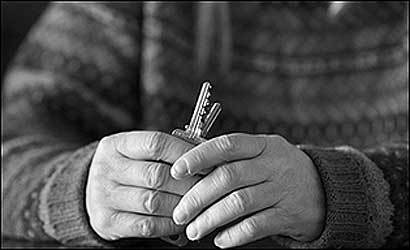change.orgEND HOMELESSNESS by Shannon Moriarty
Published October 06, 2008 @ 09:44PM PT

(Photo courtesy of www.bostonglobe.com)
Housing First is an innovative, new approach to ending homelessness. Developed in the 1990s by Pathways to Housing, Inc. in New York City, Housing First is based on the belief that homeless individuals and families respond best to professional intervention after they are secure in their own housing. Rather than move homeless people through a "continuum of care" (streets to shelter, shelter to transitional housing, transitional housing to apartment, etc.), Housing First immediately takes homeless people off the streets or out of shelter and into their own apartment with supportive case management services.
Nan Roman, president of the National Alliance to End Homelessness, sums up the latest thinking in the field:
The fundamental driver of homelessness is a lack of permanent, affordable housing. Communities all across the United States are working to end homelessness, but without the creation of new affordable units, low-income individuals and families will continue to experience homelessness. Nonprofit developers of affordable housing and local groups concerned about homelessness have a unique opportunity to form potent partnerships that can both house homeless households and build the case for more affordable housing.
According to the Boston Globe, Housing First represents "a radical shift away from the temporary shelters and soup lines that have been in place for the past two decades." In addition, it's cheaper and more effective. Between emergency room visits, repeated shelter visits, and run-ins with the law, chronically homeless individuals were costing local and federal governments between $35,000-$150,000 per person annually. With the Housing First approach, however, the annual costs drop to $13,000-$25,000 per person. Massachusetts Housing and Shelter Alliance recently reported in findings from their Housing First pilot study further describes Housing First's effectiveness:
Preliminary results show a trend towards tremendous savings in health care costs, especially hospitalizations, when chronically homeless individuals are placed into housing with services. Tenancy retention rates and improved health outcomes point to Housing First as an effective intervention for chronically homeless individuals.
Sounds great, right? But how does it actually work? Let's look at Toronto's Streets to Home Initiative, implemented in 2005. Case managers connect with clients through emergency shelters or walk-in case management services. One-on-one, clients work with their case manager on each step of acquiring housing, including applications, accessing income supports, and finding a home. From there, there are three main program requirements:
Clients must participate in follow-up services, must apply for subsidized housing, and the government pays the rent directly to the landlord (instead of providing assistance to the client for payment to the landlord). Once clients move into housing, the program provides mandatory follow-up services for one year. Follow-up workers provide the services needed to help their clients transition from the streets into housing, often checking in with landlords and building managers to directly address any problems that might arise. They also link clients to community and social services to develop life skills. Through the development of a plan and intensive goal setting, visits by follow-up workers decrease over time.
As Housing First is implemented as part of 10 Year Plans to End Homelessness across the country, cities are seeing successful results. According to the New York Times, the first cities to implement Housing First are reporting turnarounds. In Philadelphia, street dwellers have declined 60 percent over five years. In San Francisco, the number of the chronic homeless is down 28 percent in two years, in Dallas 26 percent and in Raleigh-Durham, N.C., 15 percent.


No comments:
Post a Comment